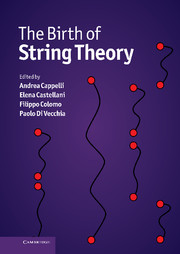Book contents
- Frontmatter
- Contents
- List of contributors
- Photographs of contributors
- Preface
- Abbreviations and acronyms
- Part I Overview
- EARLY STRING THEORY
- Part II The prehistory: the analytic S-matrix
- Part III The Dual Resonance Model
- Part IV The string
- 19 Introduction to Part IV
- 20 From dual models to relativistic strings
- 21 The first string theory: personal recollections
- 22 The string picture of the Veneziano model
- 23 From the S-matrix to string theory
- 24 The analogue model for string amplitudes
- 25 Factorization in dual models and functional integration in string theory
- 26 The hadronic origins of string theory
- TOWARDS MODERN STRING THEORY
- Part V Beyond the bosonic string
- Part VI The superstring
- Part VII Preparing the string renaissance
- Appendix A Theoretical tools of the Sixties
- Appendix B The Veneziano amplitude
- Appendix C From the string action to the Dual Resonance Model
- Appendix D World-sheet and target-space supersymmetry
- Appendix E The field theory limit
- Index
24 - The analogue model for string amplitudes
from Part IV - The string
Published online by Cambridge University Press: 05 May 2012
- Frontmatter
- Contents
- List of contributors
- Photographs of contributors
- Preface
- Abbreviations and acronyms
- Part I Overview
- EARLY STRING THEORY
- Part II The prehistory: the analytic S-matrix
- Part III The Dual Resonance Model
- Part IV The string
- 19 Introduction to Part IV
- 20 From dual models to relativistic strings
- 21 The first string theory: personal recollections
- 22 The string picture of the Veneziano model
- 23 From the S-matrix to string theory
- 24 The analogue model for string amplitudes
- 25 Factorization in dual models and functional integration in string theory
- 26 The hadronic origins of string theory
- TOWARDS MODERN STRING THEORY
- Part V Beyond the bosonic string
- Part VI The superstring
- Part VII Preparing the string renaissance
- Appendix A Theoretical tools of the Sixties
- Appendix B The Veneziano amplitude
- Appendix C From the string action to the Dual Resonance Model
- Appendix D World-sheet and target-space supersymmetry
- Appendix E The field theory limit
- Index
Summary
The beginnings
I started research in the year 1957, at the time when aspiring particle physicists were being channelled into the arid field of dispersion relations, and field theory was out of fashion. I did not find the methods of analysis employed in trying to extract information out of dispersion relations to my taste. The only tool available was the analyticity of the S-matrix, as constrained by the requirements of causality, that there should be no output before input. To give an instance of the attitude to mathematics at the time, we graduate students were advised that the only pure mathematical courses worth attending were those on functional analysis, or the theory of several complex variables! The philosophy of logical positivism reigned supreme, in which one was not allowed to talk about the unobservable features of particle interactions, but only about properties of asymptotic states. This was one of the features which inhibited the invention of the concept of quarks. I had been impressed by the tractability of electrodynamics and quantum mechanics as an undergraduate, and what Wigner has called ‘The unreasonable effectiveness of Mathematics in the Natural Sciences’. In the middle of year 1968 I was feeling very pessimistic about the possibility of theorists ever being able to say anything about scattering amplitudes for hadrons, beyond the simple tree and Regge pole approximations, and was contemplating changing fields.
- Type
- Chapter
- Information
- The Birth of String Theory , pp. 283 - 293Publisher: Cambridge University PressPrint publication year: 2012
- 4
- Cited by



